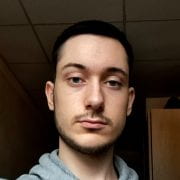George Davies
Research Interests
Computer Vision and Machine Learning
Presentations
- “A computer-vision based training coach for computerised physical training” (poster) – AgriFoRwArdS CDT Annual Conference 2024: Robots in Action [July 2024] – Norwich, UK.
- “SLAM (Simultaneous localisation and mapping)” (oral) – AgriFoRwArdS CDT Summer School: Robotic Phenotyping [July 2024] – Wageningen, The Netherlands.
- “A Computer Vision Based Training Coach for Computerised Physical Training” (poster) – AgriFoRwArdS CDT Summer School: Robotic Phenotyping [July 2024] – Wageningen, The Netherlands.
About me
I moved back to England after 11 years in France to start my undergraduate degree in computer science in 2019 at the University of East Anglia where I found the Computer Vision and Machine Learning modules very interesting. The thing I like the most about Lincoln is how close everything is, how it is possible to walk to any place. In my spare time, I like to go play a bit of snooker or pool. I have recently built my own PC and enjoy playing competitive esports games on it. After the 2023/24 year in Lincoln, I will be going back to UEA were I will complete my PhD.
MSc Project
A computer-vision based training coach for computerised physical training
The project aims to develop a physical training coach application guiding the user to perform aerobic and resistance training exercises. The system will identify specific landmarks related to the user’s posture and be able to track whether the user performs the exercises correctly (e.g. counting the number of repetitions). It will monitor the user’s improvement and motivate them through a rewarding strategy and updating the difficulty level.
PhD Project
Beyond the visible – spectral imaging and analysis for crop health and yield monitoring
NIAB undertakes a comprehensive range of plant health and disease tests and field experiments for key agricultural and horticultural crops in the UK, geared towards the testing and exploitation of host-plant resistance and sustainable crop management. For example, to rapidly discover Septoria disease could protect wheat from Septoria tritici blotch disease, which is causing 30% wheat yield loss annually in Europe; conducting precise orchard management for marketable yield prediction. Hence, NIAB aims to establish an objective, quantitative, and scalable assessment method to monitor the disease and crop health via hyperspectral (HS) imaging, which will enable accurate pathogen population and crop performance surveillance in variable diseases under changing climates. This is not yet reliably carried out in the UK and the EU, as industry still largely depends on field walking by trained agronomists to cover field areas in various sampling patterns to detect incipient diseases or crop performance visually. It is time-consuming, costly and prone-to-errors.
To improve on the efficiency and speed of the process of plant disease discovery and crop health surveillance, we are aiming to collect the relevant HS image datasets at NIAB. The focus will be on the Septoria disease and apple orchards, but other plant diseases and crops might be included as the project progresses. We will identify key spectral signatures in the HS data where the diseased and healthy samples differ for the relevant range of agricultural (e.g. wheat) and horticultural crops (e.g. apples) under a broad range of daylight locus illumination spectra. Recent developments in hyperspectral imaging suggests that VNIR (400–1000nm) and SWIR (900–2500nm) HS cameras might provide a solution in detecting Septoria at early stages and orchard health (i.e. from blossom to fruitlet). We will design and evaluate a multispectral (MS) imaging system optimised to robustly discriminate the diseased and healthy samples under the broad range of daylight illuminations. The identification of relevant spectral signatures in the hyperspectral data, their variability for different stages of the disease and under relevant daylight illuminations opens the possibility of the design of a much simpler, cheaper and more portable solution that could be used in practice in the field. It is envisaged that the practical solution to crop health monitoring in the field might require the use of MS rather HS solution. MS solution would be optimised for finding the spectral signatures identified in the HS data. Finally, we will develop and evaluate machine learning algorithms utilising deep learning for the detection, classification and monitoring over time of the diseased/healthy (and other relevant plant conditions in) wheat and apple orchards with the HS or MS imagery as input.
George’s PhD project is being carried out in collaboration with NIAB and under the primary supervision of Dr Michal Mackiewicz.

